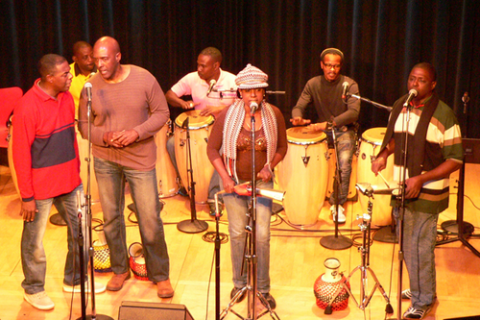Toques and Timba with Los Hermanos Arango

The Arango family sing together during the percussion clinic.
Photo by Jonathan Page

Percussionists play the batá drums.
Photo by Jonathan Page

Los Hermanos Arangos
Photo by Jonathan Page
At the start of the Hermanos Arango concert at Berklee, one of the percussionists set a plate of food down on the edge of the stage, sipped from a cup, and sprayed the liquid over the food in a Santería blessing. It was a striking moment that exemplified how the Arangos combine traditional and modern elements in their music. The group bills itself as the only Cuban band to use completely unaltered Afro-Cuban ritual vocals and hand drumming as the basis for a modern repertoire. Brothers Feliciano (bass), Eugenio (voice, percussion), Ignacio (guitar), and sister Cristina (voice) head the group, with percussionists Lazaro Aguiar, Jesus Lara Oviedo, and Francisco Castellanos backing them.
In the first half of their concert, the Arangos performed music used in Santería religious ceremonies, or toques, with specific and very complex rhythms played on the batá drums representing each of the gods (or orishas). These were either without vocals (oru seco) or accompanied by call-and-response chanting and sometimes dancing. These folkloric beats and chants were incorporated into the Arangos' modern repertoire in the second half of the show, when Berklee students on trumpet, saxophone, piano, and more were brought out to accompany the band.
For students who were curious about the techniques behind the music, the Arangos held clinics over the next two days.
Feliciano Arango, original bassist for the iconic timba group NG La Banda, taught the bass clinic, with assistance from Cherina Mastrantones, with whom he collaborated on the book Cuban Timba: A Contemporary Bass Technique. With frequent pauses for translation, he walked students through some of the basic concepts explained in the book. In the process he traced the development of Cuban bass playing, starting with son clave. Feliciano explained how timba changed the bass style, breaking from the traditional five-stroke clave rhythm pattern. He related that when it first developed in the '90s, timba was criticized as hard to dance to because of its dense, syncopated bass line. Now, with the desire for more agressive dancing, Cuban music has evolved even further, but Feliciano emphasized that it's important for new students to start with the basic steps of son and danzón before moving on to timba, explaining that Cuban musicians had to do the same sort of musical backpedaling when they first absorbed jazz. With such a broad view, it was, as Bass Department chair Rich Appleman said, "a bass clinic—and more."
The next day Eugenio Arango gave a clinic on the polyrhythmic percussion in the Arangos' music. The event began with a sort of history lesson, translated from Spanish, explaining that the rhythms came from the African Yoruba religion, brought to Cuba by slaves. These are played by religious brotherhoods in the provinces of Havana and Matanzas as prayers to the potencias (powers). Eugenio went on to describe the uses of the many percussion instruments on stage. The three batá drums play the patterns for each god, with blessed drums used solely in the religious ceremonies and not for entertainment. The three congas, the claves, the cowbell, and the chékeres (gourd rattles) filled out the percussion section.
Percussion is so important to their music that each member of the Arango family, no matter their primary instrument, doubles on percussion (as well as voice), and they switched instruments often to show examples of different rhythms. Students slapped their knees and tapped their toes to wrap their heads around the rhythms discussed. Eugenio suggested that students begin learning the batás with the low drum, because it's the anchor, very close to the basic clave in rhythm. But Feliciano warned students who haven't grown up in that tradition to "be very careful and have a lot of respect, because it's a deep and important tradition."
The Arangos' visit was the continuation of a cultural exchange that began in 2010. That year Berklee students enjoyed a musical ceremony at the Arangos' home in the Guanabacoa district of Havana, and the next they performed with the group in a concert at the Casa de las Américas. The collaboration continues, as does the evolution of the music that inspires it.
